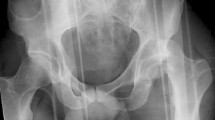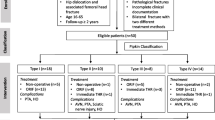Summary
The benefit of early operative stabilization of femoral fractures is established in patients with multiple injuries. In the last few years the unreamed femoral nail is favoured for internal fixation of femoral fractures despite pathophysiological concerns. The foremost advantage of femoral nails compared with plate fixation is the possibility of early full weight bearing. The aim of this retrospective study was to investigate, under consideration of the severity of injury, the extent of injury, and the clinical course, if multiple injured patients with concomitant femoral fractures benefit from the preferred intramedullary nailing with early weight bearing. Three hundred and two (23.8 %) out of 1271 multiple injured patients (ISS > 17) had a concomitant femoral fracture. Fourty-seven out of 302 patients were children under 16 years of age, remaining 255 patients. Eighteen out of 255 patients died within the first 21 days after trauma and 66 patients required mechanical ventilation for more than three weeks (171/255). Thirty patients suffered from severe head injury (AIS-head > 3) and seven from severe pulmonary contusion with concomitant abdominal injury (134/255). Two patients had grade III open femoral fractures with vascular injury. Ipsilateral unstable pelvic fratures were seen in 11 patients, seven patients had ipsilateral intraarticular femoral fractures, and ipsilateral intraarticular fractures of the lower leg or foot were observed in 40 patients (74/255). The results demonstrate, that only 74 (29 %) out of 255 multiple injured patiens ( > 16 years of age) had a theoretical benefit of early weight bearing. Seventy percent of the patients did not benefit from intramedullary nailing considering full weight bearing. With regard to pathophysiological concerns alternative methods of fracture fixation should be discussed for these patients. Primary fracture fixation with external fixators and secondary internal fixation proved to be a save alternative method. The complication rate of plating is comparable to intramedullary nailing but associated with less severe systemic risks. Primary plating of femoral fractures would not delay mobilization of most multiple injured patients.
Zusammenfassung
Der Vorteil der primären operativen Stabilisierung von Femurfrakturen beim Polytraumatisierten ist anerkannt. Trotz grundsätzlicher pathophysiologisch begründeter Einwände gegen einen intramedullären Kraftträger zur primären Stabilisierung der Oberschenkelfraktur wird in den letzten Jahren zunehmend der ungebohrte Marknagel favorisiert. Zentrales Argument der Befürworter des Marknagels ist die Frühbelastbarkeit. In der vorliegenden retrospektiven Studie wurde untersucht, wieviele Polytraumatisierte mit Femurfraktur unter Berücksichtigung der Verletzungsschwere, des Verletzungsmusters und des klinischen Verlaufes den Vorteil der Frühbelastung nach primärer Marknagelung hätten nutzen können. Von 1271 polytraumatisierten Patienten (PT) (ISS > 17 Punkte) hatten 302 (23,8 %) eine Femurfraktur, davon 47 Kinder < 16 Jahre, so daß 255 PT zur Frage der primären Stabilisierungsform verblieben. Von den 255 PT (100 %) verstarben 18 PT innerhalb der ersten 21 Tage und 66 PT mußten länger als 21 Tage auf der Intensivstation behandelt werden (171/255); 30 PT erlitten ein Schädel-Hirn-Trauma III° und 7 eine schwere Lungenkontusion mit begleitender Abdominalverletzung (134/255); 2 PT hatten III° offene Femurfrakturen mit Gefäßrekonstruktion. Ipsilaterale Beckenverletzungen hatten 11 PT, 7 PT Gelenk- bzw. gelenknahe Frakturen des gleichen Femurs und 40 PT hatten ipsilaterale Gelenkfrakturen am Unterschenkel bzw. Fuß (74/255). Retrospektiv hätten von 255 PT > 16 Jahre mit Femurfraktur nur 74 (29 %) die Möglichkeit der Frühbelastung einer Marknagelung nutzen können. Da mehr als 70 % der PT die Marknagelung einer Femurfraktur unter dem Aspekt „Frühbelastung“ nicht hätten nutzen können, stellt sich unter Zugrundelegung pathophysiologischer Bedenken die Frage, ob nicht für diese Patienten alternative Stabilisierungsformen gewählt werden sollten. Für schwerstmehrfachverletzte Patienten steht primär der Fixateur externe mit sekundär möglichem Verfahrenswechsel zur Verfügung. Für einen großen Teil der Polytraumatisierten würde eine primäre Plattenosteosynthese der Femurfraktur bei geringerem systemischen Risiko und gleicher Komplikationsrate die Mobilisierung nicht verzögern.
Similar content being viewed by others
Author information
Authors and Affiliations
Rights and permissions
About this article
Cite this article
Neudeck, F., Aufmkolk, M., Voggenreiter, G. et al. How many multiple trauma patients benefit from the biomechanical advantage of intramedullary nailing of femur fractures regarding early weight bearing?. Unfallchirurg 101, 769–774 (1998). https://doi.org/10.1007/s001130050336
Published:
Issue Date:
DOI: https://doi.org/10.1007/s001130050336




